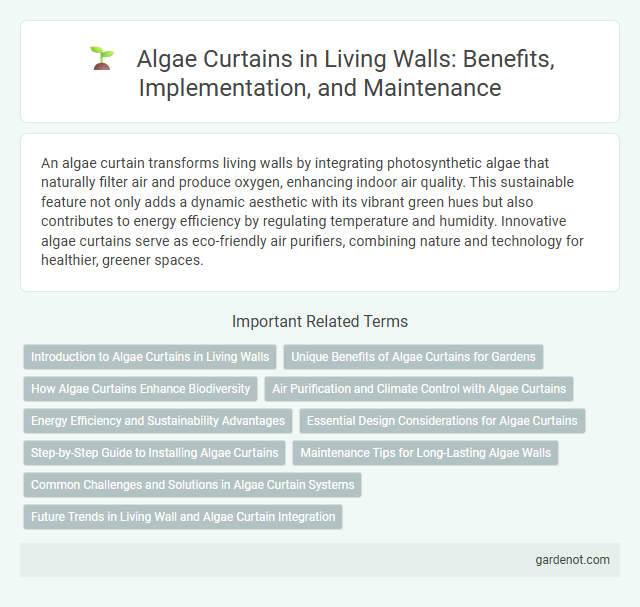An algae curtain transforms living walls by integrating photosynthetic algae that naturally filter air and produce oxygen, enhancing indoor air quality. This sustainable feature not only adds a dynamic aesthetic with its vibrant green hues but also contributes to energy efficiency by regulating temperature and humidity. Innovative algae curtains serve as eco-friendly air purifiers, combining nature and technology for healthier, greener spaces.
Introduction to Algae Curtains in Living Walls
Algae curtains in living walls are innovative biophilic design elements that combine natural aesthetics with sustainable air purification. These curtains utilize photosynthetic algae cultures encapsulated within transparent panels, effectively absorbing CO2 and producing oxygen while reducing indoor air pollutants. Integrating algae curtains enhances building energy efficiency by providing natural insulation and contributes to healthier indoor environments through continuous bio-filtration.
Unique Benefits of Algae Curtains for Gardens
Algae curtains provide exceptional natural air purification in gardens by absorbing carbon dioxide and releasing oxygen through photosynthesis, enhancing overall air quality. Their biomass can be harvested sustainably for biofuel or fertilizer, promoting eco-friendly resource utilization. The dynamic movement of algae curtains adds a visually calming element while regulating temperature and humidity levels in outdoor spaces.
How Algae Curtains Enhance Biodiversity
Algae curtains enhance biodiversity by providing a unique habitat that supports diverse microorganisms and small aquatic species, fostering a balanced ecosystem within urban spaces. These living walls improve air and water quality through photosynthesis, promoting healthier environments for plants and animals. Their integration into architectural designs encourages natural interaction between species, increasing urban biodiversity and ecological resilience.
Air Purification and Climate Control with Algae Curtains
Algae curtains enhance air purification by absorbing carbon dioxide and releasing oxygen through natural photosynthesis, significantly reducing indoor air pollutants and improving air quality. They contribute to climate control by regulating ambient temperature and humidity, creating a cooler and more comfortable indoor environment. Integrating algae curtains in living walls promotes sustainable building design by lowering energy consumption for heating and cooling.
Energy Efficiency and Sustainability Advantages
Algae curtains enhance energy efficiency by naturally regulating indoor temperatures through photosynthesis, reducing the reliance on artificial cooling and heating systems. These living walls improve air quality by absorbing carbon dioxide and releasing oxygen, contributing to sustainability goals in urban environments. Their ability to filter pollutants and generate biomass positions algae curtains as innovative, eco-friendly solutions for green architecture.
Essential Design Considerations for Algae Curtains
Algae curtains require careful consideration of light exposure, water flow, and nutrient supply to optimize photosynthesis and growth. Selecting appropriate algae species with high oxygen production and adaptability to urban environments enhances air quality benefits. Structural design must ensure ease of maintenance and integration with existing living wall systems for sustainable operation.
Step-by-Step Guide to Installing Algae Curtains
Begin the installation of algae curtains by selecting a suitable location with ample natural light and mounting a sturdy frame to support the algae growth medium. Prepare the algae culture by mixing the appropriate species in a nutrient-rich solution, then evenly distribute this mixture across the curtain's substrate. Maintain optimal conditions by regulating temperature, light exposure, and water flow to ensure healthy algae proliferation and maximize the curtain's environmental benefits.
Maintenance Tips for Long-Lasting Algae Walls
Regular cleaning of algae curtains prevents buildup that can inhibit photosynthesis and reduce wall vitality. Maintaining optimal light exposure between 1000-2000 lux and ensuring consistent water flow with adequate nutrients supports healthy algae growth. Monitoring water quality parameters such as pH (6.5-8.0) and temperature (20-25degC) minimizes algae stress and prolongs the lifespan of living algae walls.
Common Challenges and Solutions in Algae Curtain Systems
Common challenges in algae curtain systems include biofilm clogging, uneven light distribution, and nutrient imbalances that hinder algae growth efficiency. Solutions involve integrating self-cleaning surfaces to reduce biofilm buildup, employing optimized LED lighting for uniform exposure, and implementing automated nutrient dosing systems to maintain optimal algae health. Regular monitoring using sensors and AI analytics enhances system performance and mitigates maintenance issues in living wall algae curtains.
Future Trends in Living Wall and Algae Curtain Integration
The integration of algae curtains in living walls represents a cutting-edge trend, combining sustainable design with bioengineering to enhance air purification and energy efficiency in urban architecture. Advances in photobioreactor technology enable algae curtains to not only improve building aesthetics but also generate biomass for biofuel, positioning them as a multifunctional solution. Future developments are expected to focus on optimizing algae species and curtain systems for greater carbon capture and thermal regulation, driving smarter, eco-friendly living environments.
Algae curtain Infographic

 gardenot.com
gardenot.com